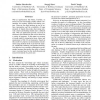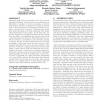300 search results - page 39 / 60 » Sampling Representative Users from Large Social Networks |
ICMCS
1994
IEEE
13 years 11 months ago
1994
IEEE
As computers are increasingly used to mediate social interaction, tools are needed not only to support direct communication, but also to create a richer social environment for the...
WIOPT
2010
IEEE
13 years 5 months ago
2010
IEEE
—Cognitive radio networks provide the capability to share the wireless channel with licensed (primary) users in an opportunistic manner. Primary users have a license to operate i...
LWA
2007
13 years 9 months ago
2007
Web 2.0 applications like Flickr, YouTube, or Del.icio.us are increasingly popular online communities for creating, editing and sharing content. However, the rapid increase in siz...
KDD
2012
ACM
11 years 10 months ago
2012
ACM
Influential people have an important role in the process of information diffusion. However, there are several ways to be influential, for example, to be the most popular or the...
CIKM
2010
Springer
13 years 6 months ago
2010
Springer
Non-negative tensor factorization (NTF) is a relatively new technique that has been successfully used to extract significant characteristics from polyadic data, such as data in s...


